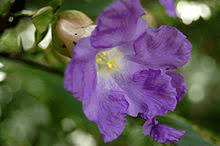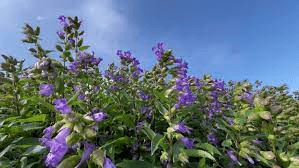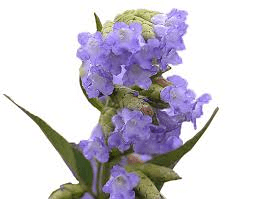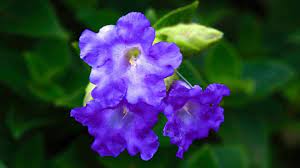Strobilanthes callosa, commonly known as Neelakurinji, is a mesmerizing flowering plant that belongs to the Acanthaceae family. Endemic to the Western Ghats mountain range in South India, this species has garnered significant attention due to its unique flowering behavior.
Neelakurinji is renowned for its mass blooming events that occur once every 12 years, a phenomenon that captivates both botanists and nature enthusiasts alike.
The name “Neelakurinji” translates to “blue flower” in the local Malayalam language, aptly describing the striking violet-blue hue of its blossoms.
The plant typically grows in the shola-grassland ecosystems of the Western Ghats, thriving at elevations ranging from 1300 to 2400 meters above sea level. Neelakurinji is characterized by its lance-shaped leaves, covered with fine hairs, providing a distinctive texture to the plant.
The most remarkable feature of Strobilanthes callosa is its synchronized flowering event, known as a gregarious or mast flowering episode. During this rare occurrence, which happens once in 12 years, the hillsides are transformed into a breathtaking sea of blue blooms, creating a visual spectacle.
This synchronized flowering strategy is believed to be an evolutionary adaptation, helping the plant overwhelm potential herbivores and increase the chances of successful pollination.
The ecological significance of Neelakurinji extends beyond its aesthetic appeal. The blooming period attracts a plethora of pollinators, including butterflies, bees, and other insects, contributing to the overall biodiversity of the region.
Additionally, the cyclic nature of its flowering has implications for nutrient cycling and ecosystem dynamics in the Western Ghats.
Conservation efforts have been implemented to protect the unique habitats where Strobilanthes callosa thrives, recognizing the ecological importance and cultural significance of Neelakurinji in the biodiversity-rich Western Ghats.
As scientists continue to study and monitor these periodic flowering events, Neelakurinji stands as a captivating symbol of nature’s intricate and synchronized rhythms.
The Botanical Description of Strobilanthes callosa
1. Leaves: The leaves of Strobilanthes callosa are elliptical to lanceolate, possessing a glossy texture and a deep green color. They are arranged in opposite pairs along the stems.
2. Flowers: The plant produces showy, tubular flowers that are typically a striking shade of violet or purple. These flowers are arranged in dense spikes, creating a visually appealing display.
3. Height: Strobilanthes callosa is a shrub that can reach a height of about 1 to 2 meters, forming a well-branched and compact structure.
4. Stem: The stems of the plant are sturdy and covered with fine hairs, contributing to its overall texture.
5. Habitat: This species is native to the Nilgiri Hills in Southern India, thriving in the cool and moist environments of mountainous regions.
6. Blooming Season: Strobilanthes callosa typically blooms during the late monsoon season, with flowers emerging in abundance, transforming the landscape with vibrant colors.
7. Adaptability: The plant is well-adapted to hilly terrains and is often found in the understorey of forests, thriving in the shade provided by taller vegetation.
8. Reproduction: Strobilanthes callosa reproduces through seeds, and its growth is influenced by factors such as soil quality, temperature, and precipitation.
9. Fragrance: While the plant is not known for a strong fragrance, the visual appeal of its colorful flowers makes it a sought-after ornamental species.
10. Conservation Status: Depending on its specific location, Strobilanthes callosa may be subject to conservation efforts due to factors such as habitat loss or climate change.
The Geographic Distribution of Strobilanthes callosa

1. Native Range: The plant is native to the Nilgiri Hills, a mountainous region in the Western Ghats of Southern India. It thrives in the cool and moist conditions of these elevated landscapes.
2. Altitude: Strobilanthes callosa is typically found at higher altitudes, flourishing at elevations ranging from 1,000 to 2,400 meters above sea level.
3. Western Ghats: The Western Ghats, a UNESCO World Heritage Site, is a biodiversity hotspot that houses Strobilanthes callosa among numerous other plant species.
4. Habitat: This species prefers the understorey of forests, where it can benefit from the shade provided by taller vegetation. It is often found in the proximity of other mountainous flora.
5. Distribution Beyond India: While the primary distribution is within India, cultivation and interest in ornamental plants have led to the presence of Strobilanthes callosa in gardens and botanical collections in other parts of the world.
6. Conservation Concerns: Due to factors such as habitat fragmentation and climate change, Strobilanthes callosa may face conservation concerns in some areas of its native range.
7. Endemism: Strobilanthes callosa’s distribution is endemic to the specific ecological conditions of the Nilgiri Hills, contributing to its significance in the region’s biodiversity.
8. Ecological Role: The plant plays a role in the ecology of its native habitat, providing nectar for pollinators and contributing to the overall floral diversity of the Western Ghats.
The Chemical Composition of Strobilanthes callosa
1. Alkaloids: Strobilanthes callosa contains alkaloids, which are organic compounds known for their diverse biological activities. These compounds may contribute to the plant’s medicinal effects.
2. Flavonoids: Flavonoids, with their antioxidant properties, are present in Strobilanthes callosa. These compounds play a role in neutralizing harmful free radicals in the body.
3. Terpenoids: Terpenoids, known for their antimicrobial and anti-inflammatory properties, are part of the chemical composition of Strobilanthes callosa.
4. Essential Oils: Some species within the Strobilanthes genus may produce essential oils, contributing to the plant’s aromatic properties and potential therapeutic uses.
5. Phenolic Compounds: Phenolic compounds, recognized for their antioxidant and anti-inflammatory effects, are found in Strobilanthes callosa.
6. Tannins: Tannins, known for their astringent properties, are part of the chemical makeup of the plant. They may have implications for medicinal use.
7. Saponins: Strobilanthes callosa may contain saponins, compounds that can exhibit various biological activities, including antimicrobial and anti-inflammatory effects.
8. Glycosides: Glycosides, with their diverse pharmacological activities, are among the chemical constituents found in Strobilanthes callosa.
9. Carotenoids: Carotenoids, which contribute to the plant’s vibrant flower colors, also have antioxidant properties that may benefit human health.
10. Proteins: Strobilanthes callosa contains proteins, which are essential building blocks for various physiological processes in both plants and animals.
11. Minerals: The plant may contain essential minerals, contributing to its nutritional profile and potential health benefits.
12. Vitamins: Strobilanthes callosa may contain vitamins, which play crucial roles in various physiological functions.
13. Resins: Resins, with their protective and adhesive properties, are part of the plant’s chemical composition.
14. Lignans: Lignans, known for their antioxidant properties, may be present in Strobilanthes callosa.
15. Amino Acids: Amino acids, the building blocks of proteins, are part of the plant’s chemical makeup.
Read Also: How to Farm and Care for Haddock Fish (Melanogrammus aeglefinus)
The Medicinal Health Benefits Of Strobilanthes callosa (Neelakurinji)

1. Anti-Inflammatory Effects: Compounds found in Strobilanthes callosa exhibit anti-inflammatory properties, making it potentially beneficial for conditions involving inflammation.
2. Antioxidant Support: The plant’s chemical composition, rich in antioxidants, contributes to its ability to neutralize free radicals, providing overall antioxidant support.
3. Respiratory Health Benefits: Traditional remedies involving Strobilanthes callosa suggest its potential for supporting respiratory health. It may assist in alleviating symptoms associated with respiratory conditions.
4. Antimicrobial Properties: Strobilanthes callosa has been traditionally recognized for its antimicrobial properties, which may contribute to its effectiveness in combating certain infections.
5. Stress Reduction: Compounds within the plant may possess calming effects, making it valuable for stress reduction and potentially contributing to overall mental well-being.
6. Digestive Support: Some traditional uses highlight the plant’s role in providing digestive support, potentially aiding in gastrointestinal health.
7. Anti-Aging Properties: The antioxidant-rich nature of Strobilanthes callosa may have implications for anti-aging effects, supporting skin health and combating oxidative stress.
8. Immune System Enhancement: Traditional medicinal practices suggest that the plant may contribute to immune system enhancement, assisting the body in defending against illnesses.
9. Antipyretic Action: Strobilanthes callosa has been used traditionally for its potential antipyretic action, aiding in the reduction of fever.
10. Cardiovascular Health: The plant’s properties may have positive effects on cardiovascular health, potentially contributing to heart health.
11. Detoxification: Some traditional uses point towards Strobilanthes callosa’s role in detoxification, aiding in the removal of toxins from the body.
12. Wound Healing: The plant may have properties that support wound healing, making it a part of traditional remedies for external applications.
13. Anti-Anxiety Effects: Compounds in Strobilanthes callosa may possess anti-anxiety effects, contributing to mental well-being.
14. Anti-Diabetic Potential: Traditional uses suggest that the plant may have anti-diabetic effects, potentially assisting in managing blood sugar levels.
15. Analgesic Properties: Strobilanthes callosa has been traditionally employed for its potential analgesic properties, providing relief from pain.
16. Menstrual Health Support: Traditional practices may involve the use of Strobilanthes callosa for menstrual health, potentially alleviating associated discomfort.
17. Anti-Cancer Properties: While further research is needed, some studies suggest that the plant may have compounds with potential anti-cancer properties, inhibiting the growth of cancer cells.
The Methods of Usage to Achieve the Provided Health Benefits Of Strobilanthes callosa (Neelakurinji)
1. Herbal Teas: Infusing the leaves or flowers of Strobilanthes callosa in hot water to prepare herbal teas is a common method. This allows for the extraction of beneficial compounds.
2. Tinctures: Extracts of Strobilanthes callosa can be prepared in alcohol or glycerin, creating tinctures that provide a concentrated form of the plant’s medicinal properties.
3. Capsules or Supplements: Strobilanthes callosa supplements, available in capsule form, offer a convenient way to incorporate the plant’s benefits into one’s daily routine.
4. Topical Applications: External application of Strobilanthes callosa extracts or oils on the skin may be employed for wound healing, skincare, or addressing specific dermatological concerns.
5. Culinary Use: In some regions, Strobilanthes callosa is incorporated into culinary practices. However, it’s crucial to ensure that the plant is safe for consumption and prepared appropriately.
6. Aromatherapy: The aromatic qualities of Strobilanthes callosa may be utilized in aromatherapy, potentially providing stress-relieving and calming effects.
7. Infused Oils: Creating infused oils by steeping Strobilanthes callosa in carrier oils allows for the extraction of its beneficial compounds, suitable for external applications.
8. Poultices: Applying crushed or ground parts of Strobilanthes callosa directly to the skin as poultices may be done for localized therapeutic effects.
9. Herbal Baths: Adding Strobilanthes callosa to bathwater for herbal baths is a method to promote overall well-being and potentially address skin-related concerns.
10. Inhalation: Inhaling the aroma of Strobilanthes callosa through methods like steam inhalation may contribute to respiratory health and stress relief.
11. Dietary Integration: Incorporating Strobilanthes callosa into recipes, when applicable and safe for consumption, allows for a flavorful way to enjoy its potential health benefits.
12. Traditional Remedies: Following traditional remedies and practices associated with Strobilanthes callosa involves respecting cultural uses and wisdom passed down through generations.
The Side Effects Of Using Strobilanthes callosa Medicinal Plant
1. Allergic Reactions: Some individuals may experience allergic reactions to Strobilanthes callosa, especially if they are sensitive to plants in the Acanthaceae family.
2. Gastrointestinal Discomfort: In some cases, the consumption of Strobilanthes callosa or its extracts may lead to gastrointestinal discomfort, including issues like nausea or stomach upset.
3. Photosensitivity: Certain compounds in Strobilanthes callosa may increase sensitivity to sunlight, potentially causing skin reactions upon sun exposure.
4. Concerns During Pregnancy: Pregnant individuals should exercise caution, as there may be limited information regarding the plant’s effects during pregnancy.
5. Considerations for Breastfeeding Individuals: Nursing individuals should seek guidance from healthcare providers before using Strobilanthes callosa, considering potential impacts on breastfeeding.
6. Blood Pressure Effects: Strobilanthes callosa may have effects on blood pressure, and individuals with blood pressure concerns should monitor their levels carefully.
7. Sedative Effects: The plant may have calming effects, and excessive use may lead to sedation. Individuals should avoid activities requiring alertness if experiencing sedative effects.
8. Interaction with Medications: Strobilanthes callosa may interact with certain medications, particularly those affecting the central nervous system. Consultation with healthcare professionals is recommended.
9. Liver Health Considerations: Individuals with existing liver conditions should exercise caution, as some herbal remedies may have implications for liver health.
10. Blood Sugar Level Impact: Strobilanthes callosa’s potential anti-diabetic effects may affect blood sugar levels. Monitoring is essential, especially for individuals with diabetes.
11. Respiratory Sensitivity: Inhaled forms of Strobilanthes callosa may trigger respiratory sensitivity in some individuals. Precautions are advised for those with respiratory conditions.
12. Central Nervous System Effects : Some individuals may experience effects on the central nervous system, such as drowsiness or dizziness. Caution is advised, particularly when driving or operating machinery.
13. Skin Irritation: External applications of Strobilanthes callosa may cause skin irritation in some individuals. Patch testing is recommended before widespread use.
14. Hormonal Effects: Limited research suggests potential hormonal effects. Individuals with hormonal conditions should exercise caution and seek professional advice.
15. Pediatric Considerations: Strobilanthes callosa’s safety in children is not well-established. Consultation with healthcare providers is crucial before use in pediatric populations.
16. Duration of Use: Prolonged or excessive use of Strobilanthes callosa may lead to adverse effects. Moderation and adherence to recommended dosages are essential.
Read Also: 17 Medicinal Health Benefits Of Saffron (Crocus sativus)
The Scientific Research and Studies of Strobilanthes callosa

1. Antimicrobial Activity: Research has explored the antimicrobial properties of Strobilanthes callosa, indicating its potential in combating various microorganisms, including bacteria and fungi.
2. Anti-Inflammatory Effects: Studies suggest that Strobilanthes callosa may exhibit anti-inflammatory effects, making it a subject of interest for conditions characterized by inflammation.
3. Antioxidant Properties: The plant’s antioxidant-rich composition has been investigated for its ability to neutralize free radicals, showcasing its potential in combating oxidative stress.
4. Respiratory Health: Some studies focus on Strobilanthes callosa’s impact on respiratory health, indicating potential benefits for conditions related to the respiratory system.
5. Phytochemical Analysis: Phytochemical analysis has identified specific compounds within Strobilanthes callosa, providing insights into its chemical composition and potential bioactive constituents.
6. Wound Healing: Research has explored the wound healing properties of Strobilanthes callosa, shedding light on its traditional uses for external applications.
7. Anti-Diabetic Effects: Preliminary studies suggest that the plant may have anti-diabetic effects, showcasing potential applications in managing diabetes.
8. Hepatoprotective Effects: Some research suggests that Strobilanthes callosa may have hepatoprotective effects, indicating possible benefits for liver health.
The Safety Precautions and Recommendations In Using Strobilanthes callosa Medicinal Plant
1. Consultation with Healthcare Professionals: Individuals with pre-existing medical conditions, pregnant individuals, nursing mothers, and those taking medications should consult healthcare professionals before using Strobilanthes callosa.
2. Dosage and Duration: Adherence to recommended dosages and durations of use is crucial to prevent adverse effects associated with excessive consumption.
3. Allergic Sensitivity: Individuals with known allergies to plants in the Acanthaceae family should exercise caution and consider patch testing before using Strobilanthes callosa.
4. Sun Protection: Due to potential photosensitivity, users should take precautions to protect the skin from excessive sun exposure while using Strobilanthes callosa.
5. Monitoring Blood Pressure: Individuals with blood pressure concerns should monitor their levels regularly, as Strobilanthes callosa may have effects on blood pressure.
6. Cautions for Sedative Effects: Those experiencing sedative effects, such as drowsiness or dizziness, should avoid activities requiring alertness.
7. Interaction with Medications: Strobilanthes callosa may interact with medications affecting the central nervous system. Consultation with healthcare providers is advised for those taking such medications.
8. Liver Health Monitoring: Individuals with existing liver conditions should monitor liver health, as herbal remedies may have implications for liver function.
9. Blood Sugar Level Monitoring: Regular monitoring of blood sugar levels is essential for individuals with diabetes, considering the potential anti-diabetic effects of Strobilanthes callosa.
10. Respiratory Sensitivity Precautions: Individuals with respiratory conditions should exercise caution with inhaled forms of Strobilanthes callosa to prevent respiratory sensitivity.
11. Pediatric Use Precautions: The safety of Strobilanthes callosa in children is not well-established. Consultation with healthcare providers is recommended before use in pediatric populations.
12. Sunscreen Use: Individuals using Strobilanthes callosa or its extracts externally should consider using sunscreen to protect against potential photosensitivity.
13. Hormonal Condition Caution: Those with hormonal conditions should exercise caution due to limited research on the potential hormonal effects of Strobilanthes callosa.
14. Moderation in External Use: When applying Strobilanthes callosa externally, users should practice moderation to avoid potential skin irritation.
15. Adherence to Traditional Uses: When following traditional remedies, it’s important to respect cultural practices and adhere to the wisdom passed down through generations.
FAQs About Strobilanthes callosa Medicinal Plant
1. Is Strobilanthes callosa Safe for Consumption?
Strobilanthes callosa is generally considered safe when consumed in moderation. However, individuals with allergies or specific health conditions should exercise caution and consult healthcare professionals.
2. Can Strobilanthes callosa Be Used During Pregnancy?
Pregnant individuals should consult healthcare providers before using Strobilanthes callosa, as limited information is available regarding its safety during pregnancy.
3. What Precautions Should Nursing Mothers Take?
Nursing mothers should seek guidance from healthcare providers before using Strobilanthes callosa, considering potential effects on breastfeeding infants.
4. How Does Strobilanthes callosa Contribute to Respiratory Health?
Strobilanthes callosa has been traditionally used for respiratory health. Research suggests potential benefits for conditions related to the respiratory system, but further studies are needed.
5. Can Strobilanthes callosa Help Manage Diabetes?
Some studies suggest anti-diabetic effects of Strobilanthes callosa. Individuals with diabetes should monitor their blood sugar levels, and consultation with healthcare providers is recommended.
6. Is Strobilanthes callosa Safe for Children?
The safety of Strobilanthes callosa in children is not well-established. Consultation with healthcare providers is advised before use in pediatric populations.
7. How Does Strobilanthes callosa Affect Blood Pressure?
Strobilanthes callosa may have effects on blood pressure. Individuals with blood pressure concerns should monitor their levels regularly, and consultation with healthcare providers is recommended.
8. Are There Any Specific Considerations for External Use of Strobilanthes callosa?
External applications of Strobilanthes callosa should be done with moderation to avoid potential skin irritation. Patch testing is advisable before widespread use.
9. Does Strobilanthes callosa Have Any Sedative Effects?
Some individuals may experience sedative effects, such as drowsiness or dizziness. Caution is advised, particularly when engaging in activities requiring alertness.
10. How Can Strobilanthes callosa Be Integrated into Daily Routines?
Strobilanthes callosa can be incorporated into daily routines through various methods, including herbal teas, tinctures, supplements, culinary use (where applicable), aromatherapy, and topical applications.
11. Is Strobilanthes callosa Cultivated Beyond Its Native Range?
While native to the Nilgiri Hills in Southern India, Strobilanthes callosa may be cultivated in gardens and botanical collections in other parts of the world, particularly for its ornamental value.
12. How Can Strobilanthes callosa Contribute to Stress Reduction?
Compounds in Strobilanthes callosa may possess calming effects, contributing to stress reduction. Aromatherapy, herbal teas, and tinctures are potential methods for achieving these benefits.
13. Can Strobilanthes callosa Be Used for Wound Healing?
Research suggests that Strobilanthes callosa may have wound healing properties. External applications, such as poultices and infused oils, are traditional methods for utilizing these benefits.
14. Is Strobilanthes callosa Associated with Traditional Festivals or Customs?
In regions where Strobilanthes callosa is native, it may hold cultural significance and be associated with traditional festivals or customs. Respecting and understanding these cultural aspects adds depth to its uses.
15. How Can Strobilanthes callosa Contribute to Antioxidant Support?
The antioxidant-rich composition of Strobilanthes callosa contributes to its ability to neutralize free radicals, providing overall antioxidant support.
16. Are There Any Known Interactions Between Strobilanthes callosa and Medications?
Strobilanthes callosa may interact with medications affecting the central nervous system. Individuals taking such medications should consult healthcare professionals before use.
17. Can Strobilanthes callosa Be Used for Skincare?
External applications of Strobilanthes callosa, such as infused oils or topical creams, may be used for skincare, potentially contributing to skin health and appearance.
18. How Does Strobilanthes callosa Contribute to Detoxification?
Traditional uses suggest that Strobilanthes callosa may play a role in detoxification, aiding in the removal of toxins from the body.
Read Also: Top 20 Proven Benefits of Ginger Plant

